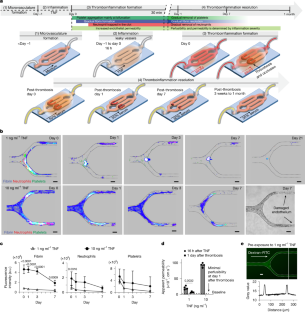2025-04-12 ジョージア工科大学
<関連情報>
- https://research.gatech.edu/3d-microchip-mimics-blood-clots-potentially-enhancing-treatment-options
- https://news.emory.edu/stories/2025/04/hs_blood_clot_conditions_04-04-2025/story.html
- https://www.nature.com/articles/s41586-025-08804-7
血栓炎症オンチップによる臨床的血栓溶解 Clinically relevant clot resolution via a thromboinflammation-on-a-chip
Yongzhi Qiu,Jessica Lin,Audrey Wang,Zhou Fang,Yumiko Sakurai,Hyoann Choi,Evelyn K. Williams,Elaissa T. Hardy,Kristin Maher,Ahmet F. Coskun,Gary Woods & Wilbur A. Lam
Nature Published:02 April 2025
DOI:https://doi.org/10.1038/s41586-025-08804-7

Abstract
Thromboinflammation occurs in various diseases, leading to life-threatening microvascular occlusion with resulting end-organ failure1,2,3,4. Importantly, how microvascular thromboinflammation resolves remains poorly understood due to the small size-scale of microvasculature and the long duration (weeks to months) of this process. Here we introduce a hydrogel-based thromboinflammation-on-a-chip model with long-term culture capabilities to model microvascular thromboinflammation and monitor clot resolution over clinically and physiologically relevant timescales (up to months). Using this system, we mapped out the distinct temporal phases of clot resolution in microvascular thromboinflammation. Using multiplexed RNA fluorescence in situ hybridization in combination with our thromboinflammation-on-a-chip model, we observed that inflammation shifts the endothelium fibrinolytic balance to favour thrombosis and pinpointed neutrophil elastase as a double-edged sword that induces clot resolution but also tissue damage. We then investigated the mechanisms of potential therapeutic agents that either prevent microvascular thrombosis or accelerate clot resolution. Specifically, we observed that, in thromboinflammation, (1) early tissue plasminogen activator administration within 3 h directly improves endothelial barrier function; (2) prophylactic defibrotide and enoxaparin suppress microvascular thromboinflammation through endothelium-mediated mechanisms; and (3) combining enoxaparin with crizanlizumab reduces microvascular occlusion and protects endothelial function in sickle cell disease. These data introduce a paradigm in investigating the underlying mechanisms of thromboinflammatory clot resolution and conducting drug discovery thereof.


